"Mantis": a hunter for shells
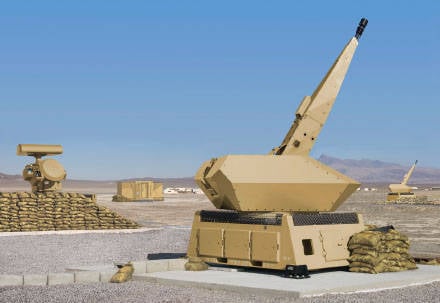 According to statistics from the International Institute for the Suppression of Terrorism IDC (Herzliya, Israel), the most common type of terrorist attacks are - contrary to well-established and widely held opinion - not bomb explosives, but rocket and mortar shelling, dividing here the palm with attacks with small arms and grenade launchers. Such a choice weapons easy to explain. First, mortars and unguided rockets are quite easy to make in an artisanal way from scrap materials, such as gun shells, scraps of water pipes, etc. Secondly, terrorists often deliberately dispose of firing positions of mortars and rocket launchers in residential neighborhoods, camps refugees, near schools, hospitals, hiding behind a kind of human shield. In this case, when attacking the firing position of terrorists, the victims among the innocent civilians are almost always unavoidable, which causes the organizers of the terrorist attack to reproach the defending side with “cruelty and inhumanity”. And finally, the third - regular attacks from mortars and rockets have a strong psychological impact.
According to statistics from the International Institute for the Suppression of Terrorism IDC (Herzliya, Israel), the most common type of terrorist attacks are - contrary to well-established and widely held opinion - not bomb explosives, but rocket and mortar shelling, dividing here the palm with attacks with small arms and grenade launchers. Such a choice weapons easy to explain. First, mortars and unguided rockets are quite easy to make in an artisanal way from scrap materials, such as gun shells, scraps of water pipes, etc. Secondly, terrorists often deliberately dispose of firing positions of mortars and rocket launchers in residential neighborhoods, camps refugees, near schools, hospitals, hiding behind a kind of human shield. In this case, when attacking the firing position of terrorists, the victims among the innocent civilians are almost always unavoidable, which causes the organizers of the terrorist attack to reproach the defending side with “cruelty and inhumanity”. And finally, the third - regular attacks from mortars and rockets have a strong psychological impact.Faced with similar tactics in Iraq and Afghanistan, NATO, at the initiative of the Netherlands, organized an ad hoc DAMA (Defense Against Mortar Attack) working group to develop a system for protecting facilities, primarily field camps, as part of the anti-terrorism general program DAT (Defense Against Terrorism). , from rocket and mortar attacks. 11 members of the North Atlantic Alliance and more than 20 companies from these countries take part in it.
Shoot down a flying fly with a rifle
Approximately the simple language is used to formulate the task of protecting against the means of RAM - this is how abbreviated jets, artillery shells and mortars are called. At the same time there are several ways to intercept small-sized air targets.
You can intercept them with a guided missile, as the Israelis do in their Iron Dome (“Iron Dome”) system. The system, developed by Rafael and put into service in 2009, is capable of intercepting targets such as 155-mm artillery shells, Qassam missiles or 122-mm rocket missiles to the MLRS "Grad", with a range of up to 70 km with probability up to 0,9 . Despite such high efficiency, this system is very expensive: the cost of one battery is estimated to be up to 170 million dollars, and launching a single rocket costs about $ 100 thousand dollars. Therefore, only the US and South Korea have shown interest in the “Iron Dome” of foreign buyers.
In European countries, the military budget is unable to finance such costly projects, so that the countries of the Old World focused their efforts on finding means of intercepting RAM, which could be an alternative to guided anti-aircraft missiles. In particular, the German firm MBDA, specializing in the production of guided missile weapons, is developing a laser facility for intercepting mortar mines, artillery and rockets as part of the C-RAM program. A prototype demonstrator with a power of 10 kW and a range of 1000 m has already been built and tested; however, a real combat system requires a laser with even higher performance and a greater (from 1000 to 3000 m) range. In addition, the effectiveness of laser weapons strongly depends on the state of the atmosphere, while the C-RAM system, by definition, must be all-weather.
Today, the most realistic way to combat missile and mortar shelling, paradoxically, is anti-aircraft artillery. Barrel artillery has a sufficiently high range and accuracy of fire, and its ammunition has the power to ensure the effective destruction of the means of RAM in the air. But the gun itself can not solve such a difficult task as "get into a flying fly from a rifle." This also requires high-precision means of detecting and tracking flying small-sized targets, as well as a high-speed fire control system for the timely calculation of firing units, guidance and programming of the fuse. All these components of the C-RAM system already exist, although they did not appear immediately, but during the rather long evolution of air defense and missile defense systems. So it probably makes sense to do a little excursion into history C-RAM technology.
C-RAM: prerequisites and predecessors
The first ever case of missile strikes in the air is probably related to 1943, when a group of allied destroyers in the Atlantic was hit by a German projectile Hs 293, which, in fact, was the world's first anti-ship guided missile. But the first officially confirmed missile interception, performed by ground anti-aircraft artillery, occurred in 1944 year. Then the British anti-aircraft gunners shot down a Fi 103 (V-1) projectile over southeastern England — a prototype of modern cruise missiles. This date can be considered the starting point in the development of anti-missile defense.
Another major milestone was the first experiments on observation with the aid of the radar of the flight of artillery shells. At the end of 1943, the operator of one of the allied radars was able to detect on the screen the marks of large-caliber shells (356 – 406 mm), issued by ship artillery. So in practice, for the first time, the possibility of tracking the trajectory of the flight of barreled artillery shells was proved. Already at the end of the war in Korea, special radar stations appeared for detecting mortar positions. Such a radar determined the coordinates of the mines at several points along which the trajectory of its flight was mathematically reconstructed and, therefore, it was not difficult to calculate the location of the enemy’s firing position from which the shelling was fired. Today, the artillery reconnaissance radar has already firmly taken its place in the arsenals of armies in most developed countries. Examples include the Russian stations CNAR-10, ARK-1 “Lynx” and “Zoo-1”, the American AN / TPQ-36 Firefinder, the German ABRA and COBRA or the Swedish ARTHUR.
The next major step in the development of C-RAM technology was made by sailors who, in the 60s and 70s, were forced to search for means of combating anti-ship missiles. Due to successes in engine building and fuel chemistry, second-generation anti-ship missiles possessed high transonic speed, small dimensions and a small effective reflective surface, which made them a “hard nut” for traditional naval air defense systems. Therefore, to protect against anti-ship missiles, small anti-aircraft artillery of 20–40 mm caliber began to be installed on ships, and high-temperature multi-barrels were often used as the artillery part of the installations aviation guns with a high density of fire. The presence of fire control radar, numerous automation and electronics turned them practically into "artillery robots", which did not require a gun crew and were activated remotely, from the operator's console. By the way, due to some external resemblance to a fantastic robot, the American full-time Vulkan-Phalanx Mk15 anti-aircraft artillery system based on the M20 Vulcan six-barreled 61-mm cannon was nicknamed R2-D2, after the well-known astromech droid from series Star Wars. Other well-known small-caliber naval anti-aircraft artillery systems (ZAK) are the Russian AK-630 with a six-barreled 30-mm GSH-6-30 K (AO-18) assault rifle and the Dutch Goalkeeper based on the seven-barreled American GAU-8/A air gun. The rate of fire of such installations reaches 5-10 thousand rounds per minute, the firing range is up to 2 km. Recently, for even greater efficiency, anti-aircraft guided missiles are also included in the ZAK, as a result of which they received the name ZRAK (anti-aircraft missile and artillery system). This, for example, is the domestic ZRAK 3 M87 Kortik with two 30-mm six-barreled machine guns and 8 ZUR 9 M311 from the Tunguska army air defense system. ZAK and ZRAK today have become standard elements of the weapons of all large warships, being the last line of defense against anti-ship missiles that have broken through the ship's air defense and a means of combating enemy low-flying aircraft and helicopters. The high potential of modern naval missile defense system is eloquently evidenced by the interception of a 114-mm artillery shell carried out by the Seawolf system (British short-range naval air defense system).
Therefore, practical Americans in creating their first C-RAM system under the name “Centurion” didn’t particularly bother with it, they just installed Vulcan Falans ZAK for an improved version of 1 B along with ground-based radar on a heavy wheeled trailer. Ammunition includes ammunition that differs from those used in the ship variant: shooting is conducted by high-explosive fragmentation (M246) or multipurpose (M940) tracer shells with self-destructing weapons. With a miss, the self-destruction device automatically undermines the projectile so that it does not pose a threat to the protected object. The C-RAM Centurion complexes were deployed in 2005 in Iraq, in the Baghdad area, to protect the locations of the American troops and their allies. According to media reports, until August 2009, the Centurion system made 110 successful interception of mortar bombs in the air. The system developer, Raytheon, is also working on a laser variant of the C-RAM system, in which, instead of the M61 gun, a 20-kilowatt laser is installed. In tests conducted in January 2007, this laser was able to hit an 60-mm mortar mine with its beam. Currently, Raytheon is working to increase the laser range to 1000 m.
Another interesting way to combat RAM targets was proposed by the German company Krauss-Maffei Wegmann, the main supplier of armored vehicles of the Bundeswehr. As a means of interception, she proposed to use the 155-mm self-propelled howitzer PzH 2000, which had been in service with the German army since 1996 and is currently one of the most advanced barreled artillery systems in the world. This project was named SARA (Solution Against RAM Attacks - a solution against RAM attacks). The highest accuracy of fire, a high degree of automation and a relatively large elevation angle (up to + 65 °) made this task technically quite feasible. In addition, 155-mm projectile is able to deliver a much larger number of striking elements to the target, which increases the size of the fragmentation cloud and the probability of destroying the target, and the PzH 2000's firing range significantly exceeds the fire range of small-caliber artillery. Another advantage of howitzers as a C-RAM tool is their versatility: they can not only intercept missiles and mines in the air, but also hit their firing positions on the ground, as well as solve all other tasks inherent in conventional artillery. KMW specialists came to such an idea after testing PzH 2000 howitzers on two Sachsen-class frigates (project F124) installed on their deck as ship-mounted artillery installations under the MONARC project. 155-mm ground guns have proved to be excellent as naval artillery, showing high efficiency of firing from a mobile carrier at moving surface and air, as well as at coastal targets. However, for technical and political reasons, the 127-mm traditional ship installation by the Italian company Oto Melara was preferred because the adaptation of the 155-mm land gun on the ship was associated with significant financial costs (for example, the use of corrosion-resistant materials, the development of new types of ammunition, etc. .).
The Bundeswehr was forced to abandon such a tempting idea as the SARA project, also for a “technical-political” reason. The main disadvantage of the PzH 2000, which was originally designed for combat in Europe, was the considerable weight that prevented the transfer of howitzers through the air. Even the newest transport plane of the Bundeswehr A400 M is not able to take PzH 2000 on board. Therefore, to transport heavy equipment over long distances, the European countries of NATO are forced to rent Russian An-124 Ruslans. It is clear that such a solution (which is considered temporary, although in reality there is no alternative to it in the foreseeable future) in the North Atlantic Alliance, not everyone likes it.
For this reason, the Bundeswehr decided to choose a path similar to the American one: to create a C-RAM system based on small-caliber artillery. However, unlike the Americans, the Germans preferred a larger caliber, 35 mm instead of 20 mm, which provides more ammunition power and greater firing range. The Skyshield 35 anti-aircraft missile system of the Swiss company Oerlikon Contraves was chosen as the base system. This company has long been one of the world leaders in the production of small-caliber guns for anti-aircraft, aircraft and naval artillery. During World War II, Oerlikon was one of the most important suppliers of 20-mm cannons and ammunition for the Axis countries: Germany, Italy and Romania. After the war, the 35-mm twin anti-aircraft gun, adopted in more than 30 countries, became the most successful product of the company. However, in view of the end of the Cold War and in connection with the failure of the ADATS anti-aircraft complex, the holding, which included Oerlikon Contraves, decided to concentrate its efforts on civilian products, and the military sector, represented by Oerlikon Contraves, became the property of the Rheinmetall Defense concern. Due to this, German specialists managed to breathe new life into such an interesting and promising development as Skyshield 1999, which, due to the organizational reasons mentioned, already seemed doomed to oblivion.
The birth of "Mantis"
The abbreviation MANTIS stands for Modular, Automatic and Network capable Targeting and Interception System (modular automatic network system for detecting and intercepting targets). This name perfectly suits the new system: in English, the word mantis also means "mantis", which, as you know, is one of the most skilled hunters among insects. The praying mantis is able to remain motionless for a long time, waiting for the victim in an ambush, and then with lightning speed to attack it: the predator's reaction time sometimes reaches just 1 / 100 seconds. The C-RAM protection system should act like a praying mantis: always be ready to open fire and in the event of a target appearing, also respond with lightning speed for its timely destruction. The name "Mantis" corresponds to the old German army tradition to give weapons systems the names of predatory animals. However, at the development stage, the system wore a different designation, NBS C-RAM (Nächstbereichschutzsystem C-RAM, i.e., the short-term protection system against RAM).
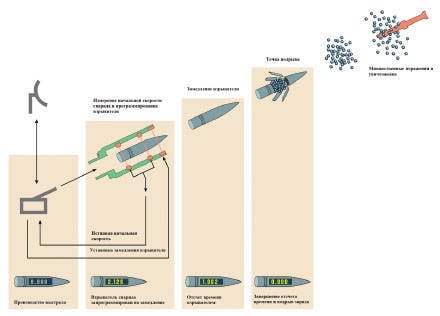 Schematic diagram of the action of the system NBS C-RAM / MANTIS
Schematic diagram of the action of the system NBS C-RAM / MANTISThe history of the development of the MANTIS system dates back to December 2004, when the Bundeswehr tested the Skyshield 35 modular anti-aircraft missile and artillery complex (GDF-007) at the Air Defense Range in Todendorf. This complex was developed on its own initiative as a promising means of combating low-flying targets by Oerlikon Contraves, which today bears the name of Rheinmetall Air Defense. Along with the missile armament, it includes a stationary tower artillery system with a remote control, equipped with an 35-mm 35 / 1000 X-gun with a rapid rate of 1000 shots / min. The German military is extremely interested in the unusually high accuracy of the Swiss installation - it is the only one of all existing small-caliber barrel systems that can hit speed small targets at distances over 1000 m. The phenomenal characteristics of the Skyshield 35 confirm another interesting fact: the ship's version of the complex, known as Millennuim (GDM-008), is able, in contrast to all known barrel systems, to detect, identify and hit even such a miniature with its 35-mm projectiles Our goal is a submarine periscope protruding above the sea (!). The tests in Todendorf proved the potential possibility of creating a C-RAM system based on the artillery component of the Skyshield complex, which was chosen as the prototype of the future NBS C-RAM / MANTIS system.
The NBS C-RAM development contract was signed in March 2007 of the year with Rheinmetall Air Defense (as Oerlikon Contraves is now called). The immediate cause of this was the Taliban rocket and mortar strikes against the field camps of the Bundeswehr in Mazar-i-Sharif and Kunduz. The Federal Office for Arms and Supplies in Koblenz has allocated millions of euros for the creation of the 48 system. It took about a year to develop the system, and already in August 2008, the system proved its combat capability at the Karapinar range in Turkey, where natural and climatic conditions are much closer to Afghan than in Tondorf located in north-west Germany. X-NUMX-mm TR-107 rocket shells from local company ROKETSAN were used as firing targets. They are a Turkish copy of the projectile to the Chinese MLRS Type 107 common in the third world countries. This installation, along with the Soviet 63-mm mortar arr. 82, considered in NATO the most common means of rocket and mortar shelling in "asymmetric wars."
Successful tests contributed to the fact that 13 in May 2009, the Bundestag approved the purchase of two NBS C-RAM systems for the Bundeswehr with a total value of 136 million euros. Delivery of the NBS C-RAM to the troops was the first step towards the creation of a future advanced integrated air defense system SysFla (System Flugabwehr), which is planned to be fully deployed in the current decade and in which NBS C-RAM plays the role of one of the basic subsystems. In 2013, the delivery of two more such systems is planned.
At this time in the Bundeswehr there were serious organizational changes that directly affected the fate of the Mantis. In July, 2010, the German Minister of Defense, as part of the announced radical reduction of the armed forces, announced the decision to liquidate the air defense forces of the ground forces, and partially assign their tasks to the Luftwaffe. Therefore, the MANTIS system was under the authority of the air force, and air defense squadrons that were part of the Luftwaffe were equipped with it. The first of these was the 1-I Schleswig-Holstein anti-aircraft missile squadron (FlaRakG 1), armed with the Patriot air defense missile system and stationed in Khusum. 25 March 2011, within the squadron, formed a special FlaGr (Flugabwehrgruppe) air defense group under the command of Lieutenant Colonel Arnt Kubart, whose goal is to develop a fundamentally new weapon system, which is MANTIS, and to train personnel for its maintenance, including for the planned use in Afghanistan. Currently, FlaGr personnel are at the training ground in Thorndorf, where they train personnel on simulators, after which it is planned to carry out final tests of the system using troop calculation forces. Organizationally, FlaGr consists of a headquarters and two squadrons, which, however, were initially staffed only with 50% due to the participation of many military personnel in foreign missions. The squadron was fully manned in 2012.
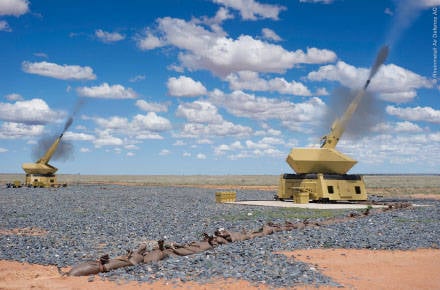 Firing test system MANTIS
Firing test system MANTISIt was announced that the development phase of the MANTIS system should be completed in 2011 year. However, the Bundeswehr apparently refused the initial intention to deploy the MANTIS system in Afghanistan to protect the ISAF forces. The leadership of the German army stated that in view of reducing the likelihood of an attack, the deployment of the so-called PRT (Provincial Reconstruction Team - local reconstruction team) in Kunduz is no longer a top priority. Other reasons were cited difficulties in providing the necessary ammunition and difficulties in setting up the system in the field.
How is the "Mantis"
The MANTIS system includes 6 artillery tower semi-stationary installations, two radar modules (also called sensors) and a fire service and control module, abbreviated as BFZ (Bedien- und Feuerleitzentrale).
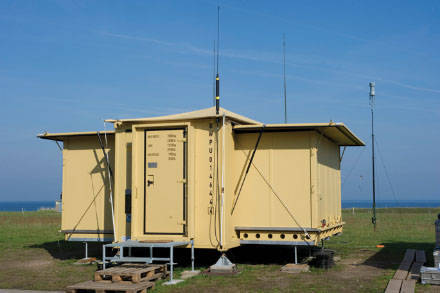 Fire service and control module
Fire service and control moduleThe MANTIS artillery installation is equipped with a single-barreled 35-mm GDF-20 turret gun, which is a variant of today's basic model Rheinmetall Air Defense, the 35 / 1000 gun. The latter was created to replace the well-known family of double-barreled guns Oerlikon KD series, adopted in service in 50-ies and designed on the basis of designs of the Second World War. In particular, the 35-mm guns of the Oerlikon KDA were armed with the best Western ZSU “Cheetah”, which up to 2010 of the year was the backbone of the Bundeswehr ground forces. Because of measures to save 2015, these ZSUs are planned to be decommissioned by the Bundeswehr, and some of the tasks solved earlier by the “Cheetahs” will be assigned to the MANTIS system.
Automatic gun works on the principle of removal of powder gases through the hole in the wall of the barrel into two gas chambers. Gases, acting on two pistons, actuate a lever that causes a four-chamber drum to rotate. With each shot, the drum turns at an angle of 90 °. For remote reloading of the gun without firing a shot, the lever can be operated hydraulically.
On the muzzle of the barrel is a device for measuring the initial velocity of the projectile. Thanks to him, there is the possibility of introducing amendments to the deviation of V0 by adjusting the time settings of the fuse. The barrel of the gun is protected by a special casing, which prevents deformation of the barrel and drum under different weather conditions (bending due to uneven heating by the sun, etc.). In addition, the gun has a variety of temperature sensors that monitor the heating of its various parts and transmit this information to the BFZ computer. This is necessary to ensure the necessary shooting accuracy required to hit small targets at a distance of several kilometers.
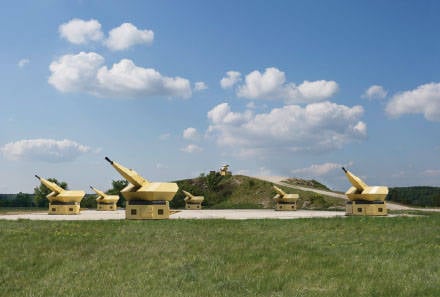 The MANTIS system includes 6 artillery mounts, 2 radar and control center
The MANTIS system includes 6 artillery mounts, 2 radar and control centerTwo guns always fire at the target at the same time, although one installation is enough to destroy it: the second unit plays the role of a backup in case of failure of the first gun. Shooting is carried out in queues up to 36 shots, the length of which is adjusted by the operator. PMD 062 rounds with projectiles of increased penetration and destructive ability, abbreviated as AHEAD (Advanced Hit Efficiency And Destruction) caliber 35 x 228 mm are used as ammunition for fighting RAM targets. Their principal device is similar to the well-known shrapnel shells, the design of which, however, has been seriously improved through the use of modern know-how. Such a projectile contains inside 152 damaging element made of heavy tungsten alloy. The weight of each 3,3 g element. Upon reaching a design point located approximately in 10 – 30 m from the target, the remote detonator explodes an expelling charge that destroys the outer shell of the projectile and pushes the striking elements. The AHEAD line of projectiles forms the so-called “fragmentation cloud” in the shape of a cone, once in which, the target suffers multiple damage and is almost guaranteed to be destroyed. AHED ammunition can be successfully used to combat small unmanned aerial vehicles, as well as lightly armored ground equipment.
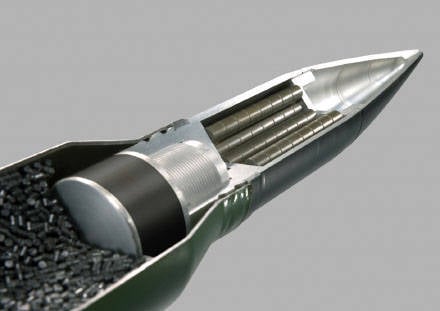 The device of an ammunition with the increased penetrative and destructive ability
The device of an ammunition with the increased penetrative and destructive abilityThe most difficult technical problem when creating an ammunition for combatting RAM was the design of a high-precision fuze that would ensure the explosion of a projectile in close proximity to the target. Therefore, it required a very short response time (less than 0,01 s) and accurate determination of the time of the explosion. The latter is achieved at the expense, as they say in NATO, of the tempering of the fuse - the programming of the fuse is carried out not before loading, as usual, but occurs at the moment of passage of a muzzle cut by a projectile. Due to this, the actual value of the muzzle projectile measured by the sensor and allowing more accurate calculation of the trajectory of the projectile and the moment of its meeting with the target is entered into the electronic block of the fuse. If the distance between the speed sensor and the fuze programming device is equal to 0,2 m, then with the speed of the 1050 projectile, m / s, only 190 microseconds are allocated to all speed measurement, ballistic calculations and input settings in the fuse memory. Perfect mathematical algorithms and modern microprocessor technology nevertheless make this possible.
The gun mount itself is mounted in a tower of circular rotation, made using stealth technology. The tower is mounted on a rectangular base with dimensions 2988 x 2435 mm, corresponding to ISO logistic standards, which allows to transport the complex in standard containers or cargo platforms.
The radar module (or sensor module) is centimeter-mounted radar mounted in a container of the company Serco GmbH. Its main feature is the ability to detect and accompany targets of very small size with a small effective reflective surface (EOP). In particular, the radar is able to reliably distinguish targets with the magnitude of the image intensifier 0,01 m 2 at a distance of 20 km. For firing at the RAM object, the artillery module only has enough information from one radar, another radar or electronic-optical guidance tools that can also be part of the complex, serve only as a reserve or for overlapping dead zones, and also to increase the range of the system .
The BFZ fire service and control module is also made in the standard ISO ISO 20 container container by Serco GmbH. The container weighing 15 t is equipped with nine workstations and guarantees protection against electromagnetic radiation in the centimeter range, characterized by the attenuation coefficient 60 decibels, as well as ballistic personnel protection - its walls can withstand the ingress of Dragunov's sniper rifle. The BFZ module contains the power supply source of the system - the 7,62 kW power generator. The staff in it is around the clock, working in shifts. Each shift consists of three operators responsible for monitoring the airspace and for the maintenance of sensors and artillery installations, and the shift commander.
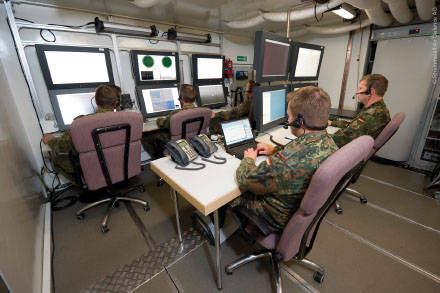 Workplaces of MANTIS system operators in the BFZ module
Workplaces of MANTIS system operators in the BFZ moduleIn principle, the degree of automation of the MANTIS system is so high that, from a technical point of view, the participation of service personnel is not required. However, due to the legal aspects regulated by NATO in the “Rules of engagement”, the use of the MANTIS system in a fully automated mode, without human participation in the decision to open fire, is not envisaged. To ensure high reaction times, appropriate selection and training of personnel for work in the BFZ is carried out. The module is equipped with means of connecting to various data transfer and information exchange networks in order to better control the surrounding situation. In addition, the system is planned to additionally introduce another medium range radar.
What's next?
First of all, we need to make a reservation that C-RAM cannot be considered an absolutely reliable means of protection against rocket and mortar attacks. This is only one, albeit a very significant, means among a whole range of measures, including defensive fortifications, the use of protective nets, warning and protection means (for example, sniper patrols), etc. Of course, like any fundamentally new technical system, C-RAM also has its own reserves, which make it possible to increase its combat effectiveness.
In particular, in the future there may be a significant expansion of the range of application of C-RAM systems Fabian Oxner, Vice President of Rheinmetall Air Defense, announced his intention to conduct tests of the MANTIS system in the current decade in order to demonstrate the fundamental possibility of destroying guided bombs and free-falling small-caliber bombs with anti-aircraft artillery fire. He stressed that the prototype of the MANTIS system, the Skyshield system, was specially created as a means of combating high-precision guided aviation weapons, such as, for example, the American anti-radar missile AGM-88 HARM. One should not be surprised here: Switzerland is a neutral state, therefore it considers potential threats from any adversaries. At the same time, a drawing of the Chinese C-RAM systems covering the ... mobile launchers of medium-range ballistic missiles was shown in the LD 2000 advertising brochure. Everyone has their own priorities: who is protecting the house, who is the oil, and who is the rockets ...
Information